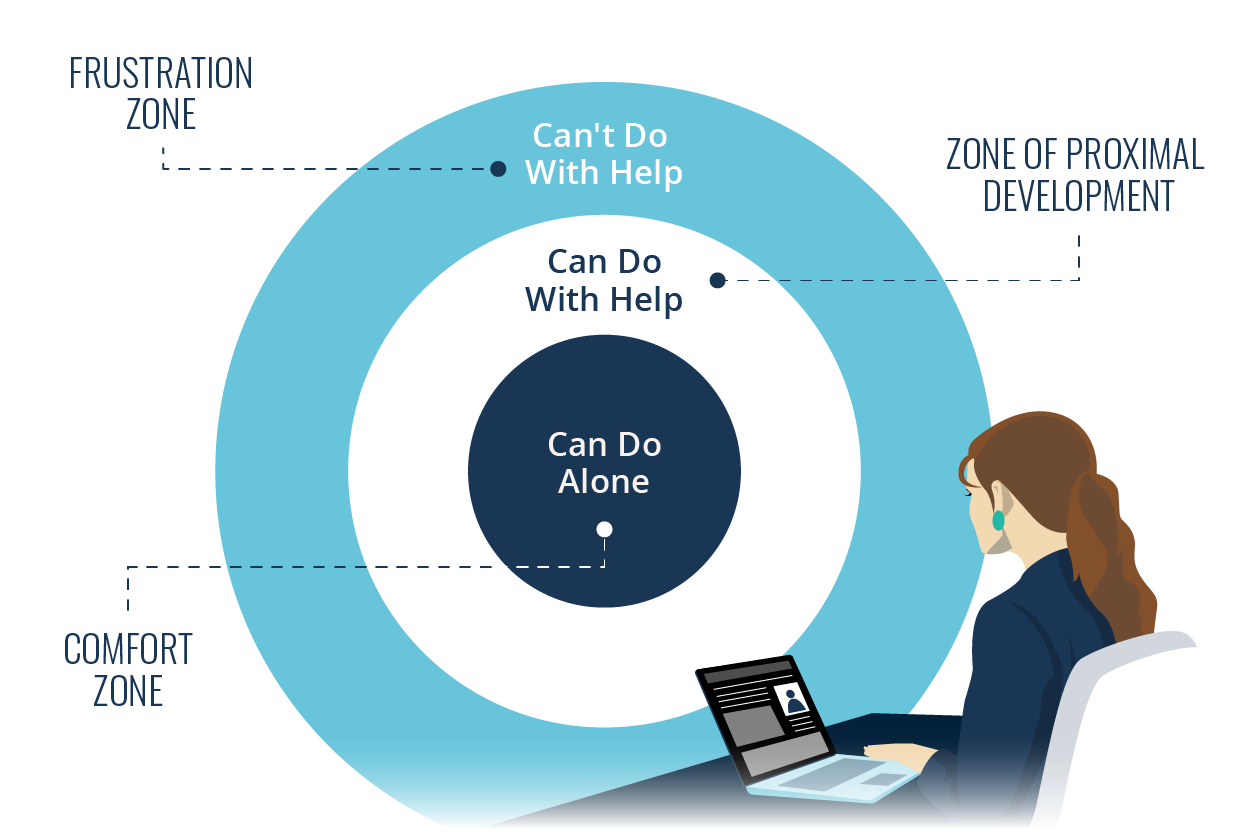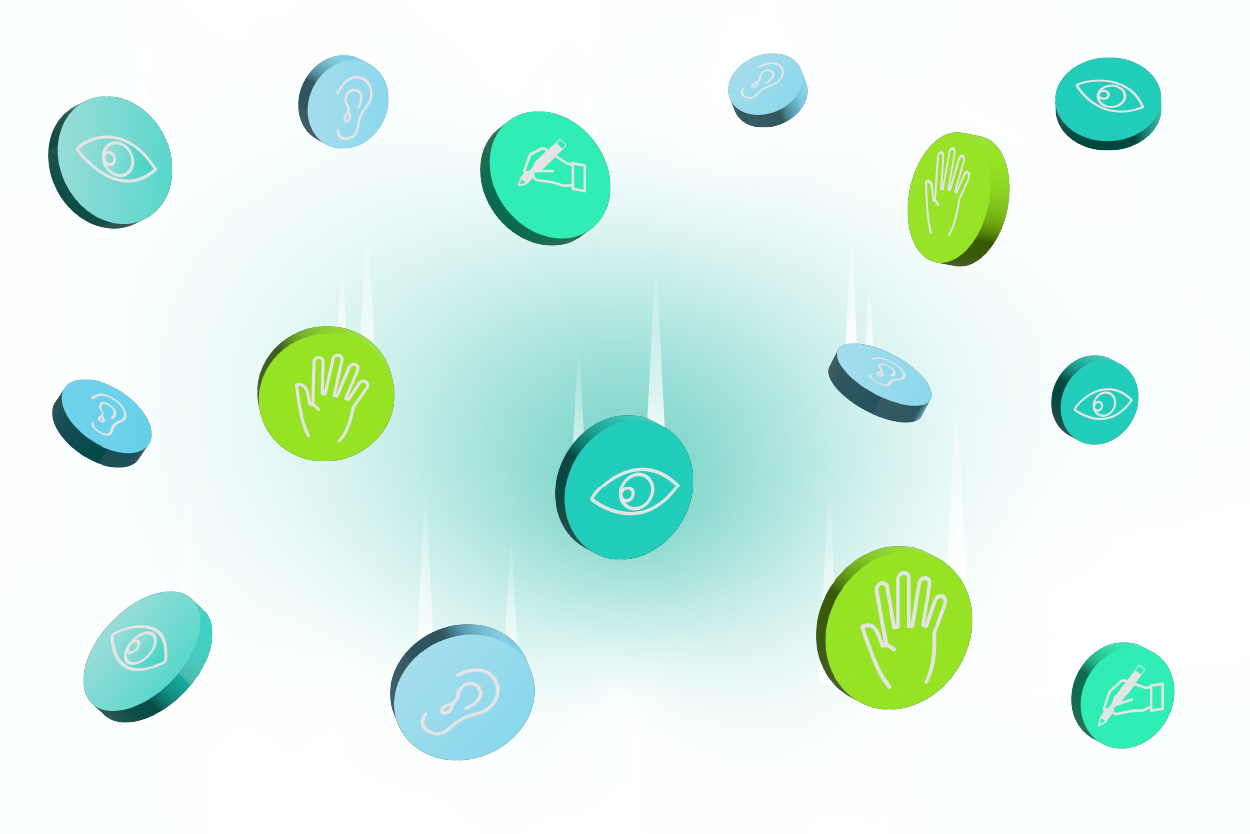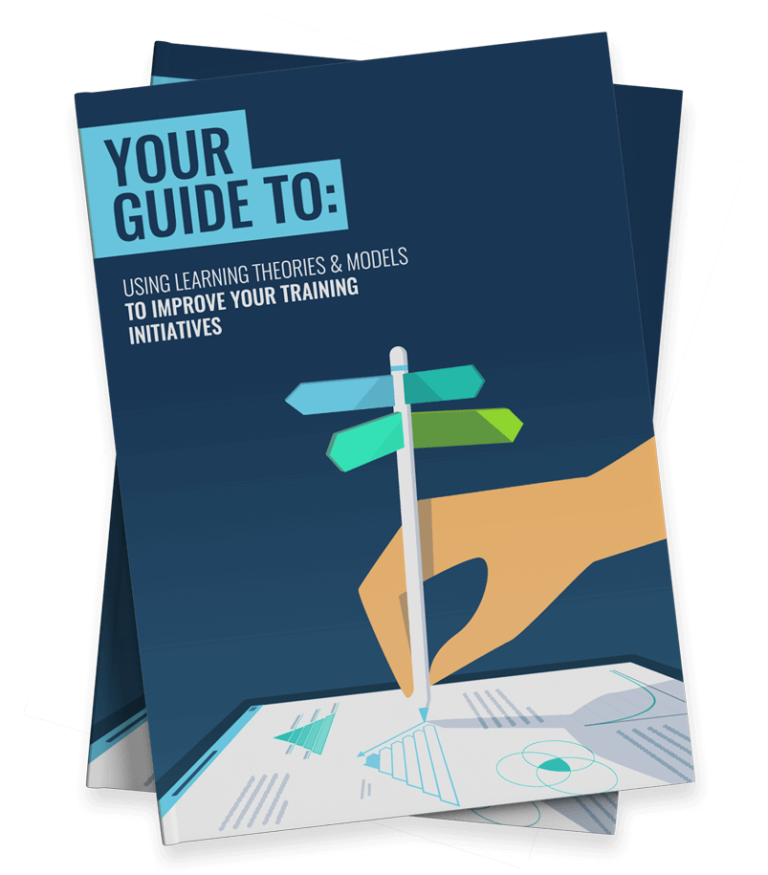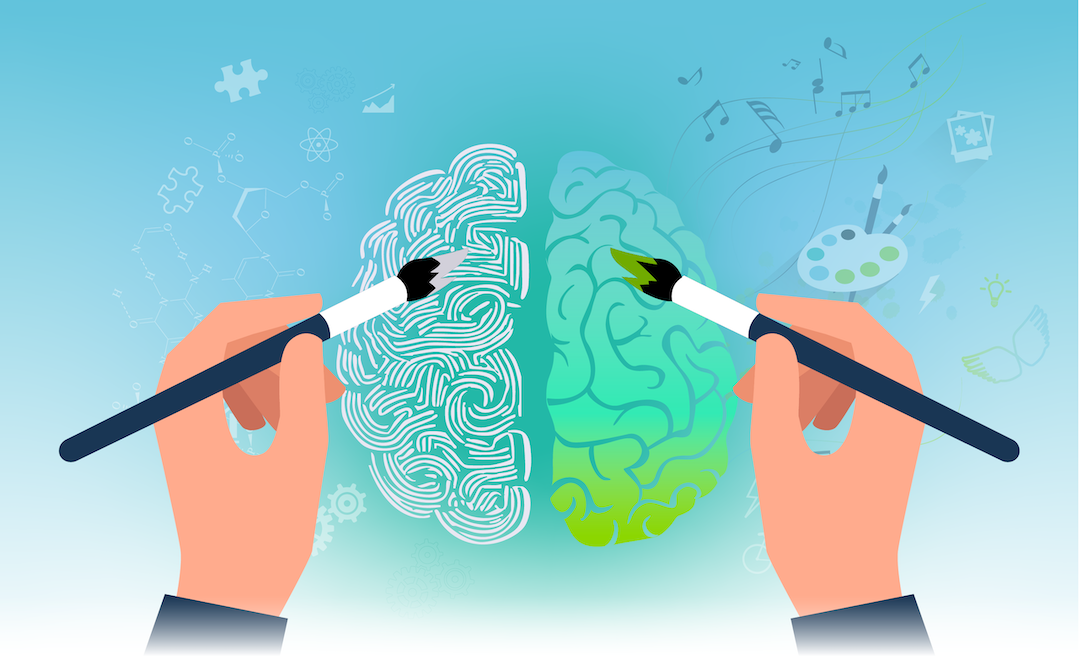
Have you ever tackled a project or skill that felt perfectly challenging? In these cases you’re stretched to learn and grow, but not to the point of feeling overwhelmed. That’s what it feels like to be in Lev Vygotsky’s Zone of Proximal Development (ZPD).
The Zone of Proximal Development might have a technical-sounding name, but it captures a simple and powerful idea in learning.
Learning within ‘the zone’ requires collaboration, the support of a more knowledgeable other, and the targeted guidance of scaffolding. By providing this, we can unlock more effective learning experiences.
As Vygotsky puts it, ‘What a child can do in cooperation today, he can do alone tomorrow’. The same is true for adult learners. After all, we all benefit from guidance and support until we can confidently tackle challenges independently.
In this article we’ll explore the origin and core principles of the Zone of Proximal Development alongside its advantages, limitations, and applications. Ready? Then let’s get in the zone!
What is The Zone of Proximal Development?
The Zone of Proximal Development is a theory in educational psychology that describes the ideal range of challenge for learning. It’s the sweet spot between what a learner can do independently and what they can do with the right guidance and support.
This is similar to the Goldilocks Principle. Just like Goldilocks wouldn’t eat porridge that was too hot or too cold, your learners won’t thrive on tasks that are excessively difficult or too simple. The Zone of Proximal Development defines that ‘just right’ zone.

Think of it this way. Any given learning experience falls into one of these three categories:
- Comfort Zone: These are tasks that learners can comfortably complete on their own without support. As a result, they’re too easy and don’t result in any real growth.
- Zone of Proximal Development: These are tasks that are challenging but achievable with help from a more knowledgeable person like an instructor, mentor or coach. This is the zone of optimal learning.
- Frustration Zone: As the name suggests, these tasks are too difficult to complete, even if you have support. Their difficulty is likely to be off-putting for your learners.
If learners are constantly presented with tasks they can already do independently, they won’t expand their knowledge base. Conversely, tasks within the Zone of Proximal Development push learners outside of their comfort zone by their very nature.
As researchers note, ZPD is an ‘inherently motivational zone’ that is ‘optimally challenging’. This encourages learners to develop new strategies and problem-solving skills. In turn, they are that much more likely to enter a flow state.
Keep in mind that your learners’ Zone of Proximal Development will change as they make progress. After all, as they begin to master skills, those tasks become part of their independent learning zone (or ‘Comfort Zone’). You should strive to introduce new challenges to keep them engaged.
What’s the Origin of The Zone of Proximal Development?
The Zone of Proximal Development originated from the work of psychologist Lev Vygotsky during the late 1920s. It wasn’t fully fleshed out until his death in 1934. He was a Soviet theorist who emphasised the social and cultural aspects of learning.
Vygotsky himself describes ZPD as ‘the distance between the actual developmental level as determined by independent problem solving and the level of potential development as determined through problem-solving under adult guidance, or in collaboration with more capable peers’.
He developed this concept to address two key educational concerns.
- Limited Testing: Vygotsky was frustrated with the limitations of traditional academic tests. He felt they only measured student’s current abilities, not their potential for growth. ZPD aimed to capture that potential by considering what learners could achieve with the right support.
- Piaget’s Lone Learner: ZPD was also developed in response to Jean Piaget’s four stages of cognitive development (get the full breakdown here). Piaget viewed children as the agents of their own learning destiny, whilst Vygotsky argued that social interaction and guidance play a key role.
What is a More Knowledgeable Other (MKO)?
The idea of a More Knowledgeable Other (MKO) is central to the concept of the Zone of Proximal Development. An MKO is anyone who has a better understanding or higher ability level than the learner when it comes to a specific task or process.
They’re not there to complete the task for the learner. Instead they act as a guide, providing scaffolding and support to help the learner achieve what they couldn’t independently. This targeted assistance bridges the gap between learners’ current abilities and their potential.
MKOs are often teachers, tutors, instructors, parents or even peers with more experience in a specific area. However, they don’t have to be a person. An MKO could also be an instructional resource like an educational video or eLearning unit.
What is Scaffolding?

Scaffolding is another crucial concept within the Zone of Proximal Development framework. It was first introduced by Wood, Bruner and Ross in 1976. It refers to the temporary support provided to learners by an MKO to help them achieve a learning goal that they couldn’t independently.
Just like scaffolding on a construction site, this support is there for workers whilst it’s needed, but it’s not meant to be a permanent fixture.
Similarly, well-designed video games often start with easier levels and gradually introduce new challenges, keeping learners engaged and motivated as they make progress.
In the same way, educational scaffolding helps learners to scale new heights. It’s then gradually removed as they become more proficient. This support can take many forms, including:
- Modelling: Demonstrating or modelling a behaviour for the learner, such as guiding them through a process step-by-step.
- Prompting: Asking learners guiding questions to stimulate thinking and problem-solving (see: The Socratic Method).
- Chunking: Breaking complex tasks down into smaller steps that are easier for your learners to manage.
- Resources: Sharing useful resources such as diagrams, videos, and tutorials with your learners.
- Feedback: Providing constructive feedback and encouragement throughout the learning experience.
By using scaffolding effectively, learning professionals can create a supportive environment that empowers their audience to move outside their comfort zone. As a result, learners will stretch their abilities, build their confidence and achieve their learning goals.
Why Does The Zone of Proximal Development Matter?
So, why did this simple concept prove to be so revolutionary? The Zone of Proximal Development is crucial for learning professionals because it equips them with a framework for understanding what their learners need. Here’s how:
- Tailored Instruction: By understanding your learners’ current abilities (or which ‘Zone’ they sit in), you can tailor your instruction to meet their specific needs. In other words, you can identify the ideal challenge level for each of your learners and ensure they don’t get overwhelmed or bored.
- Deeper Learning: If a task falls within the Zone of Proximal Development, it will push your learners beyond their comfort zone. In turn, this will encourage them to develop new skills and deepen their understanding. With the right support, this will mean richer and more meaningful learning experiences.
- Improved Motivation: Completing easy tasks doesn’t create any real sense of accomplishment. On the other hand, mastering challenges within the Zone of Proximal Development feels like a real achievement. This can provide learners with the motivation they need to keep expanding their knowledge.
- Learner Needs: The concept of the Zone of Proximal Development provides us with a welcome reminder that we all make progress at different rates. We’re all on our own learning journey. As such, it’s up to learning professionals to create an environment where each individual learner is challenged appropriately.
- Collaboration: The Zone of Proximal Development highlights the importance of social interaction within learning experiences. It suggests that effective learning isn’t simply an internal process that learners go through on their own. Indeed, as advocates for social learning approaches, we couldn’t agree more.
Examples of the Zone of Proximal Development in Action
Now we know how the Zone of Proximal Development works, and why it’s important, let’s explore its practicalities. Here are some examples of ZPD in action across different learning contexts.
- Teaching: Cast your mind back to learning about cell division in Biology class. Your teacher would likely have started with simple concepts that you could easily get your teeth into. As you gained confidence, they would have increased the difficulty level (and provided additional guidance) to keep you in the Zone of Proximal Development.
- Tutoring: Imagine learning how to play the guitar. In most cases, your tutor will start by demonstrating proper hand and finger placement and teaching you some basic chords. As you practise and improve, your tutor will reduce their support, allowing you to attempt playing simple songs independently.
- Workplace Training: Consider the last time you had to learn about a new software programme at work. There’s a good chance that a more experienced colleague provided a basic overview, followed by a step-by-step guide. If they were considering the Zone of Proximal Development, then they would have introduced the software’s more complex features only when you were ready.
Research into The Zone of Proximal Development
The Zone of Proximal Development holds a certain intuitive charm. After all, we can readily understand why a beginner might accomplish more with an expert’s guidance. But, moving beyond common sense, what does the research tell us about the effectiveness of this approach?
- This popular 2010 meta-analysis of effectiveness studies by Pol, Volman and Beishuizen notes that ‘the results suggest that scaffolding is effective’.
- This 2020 study examined students following an optimised learning path. It found that students gain ‘more mastery’ when they are assigned ‘Ready-to-Learn’ tasks rather than ‘Unready-to-Learn’ tasks.
- This 2024 study of Thai students found that cooperative learning with a more knowledgeable other ‘enhances class participation’ and motivates learners to ‘persevere through difficult tasks’.
- This 2024 study of Chinese students found that teaching guided by ZPD has a ‘very positive impact’ on ‘student learning effectiveness’ and ‘teacher reflection on learning’.
The Limitations of the Zone of Proximal Development

There’s no doubt that the Zone of Proximal Development is a powerful framework for learning. But, it’s not without its challenges and limitations. Here are some considerations for you to keep in mind:
- Finding the ZPD: Accurately pinpointing a learner’s Zone of Proximal Development is difficult, especially as it’s a moving target. It requires ongoing assessment and close observation of the learner’s skills and expertise. Indeed, keeping up can be a challenge for even the most savvy instructor.
- Scaffolding Expertise: Keeping learners in the Zone of Proximal Development requires effective scaffolding, aligned with a deep understanding of their needs and the task at hand. As with our previous Goldilocks example, everything needs to be just right. Educators may need additional training to effectively implement these strategies.
- Motivation Issues: It’s assumed that learners in the Zone of Proximal Development will be motivated to make progress, but that isn’t always the case. Students who struggle with self-doubt or lack of motivation may be unable to benefit from this approach unless these factors are also addressed.
- Over-Reliance: The Zone of Proximal Development assumes a collaborative learning experience, supported by a more knowledgeable other. However, overdependence on the scaffolding you provide could impede your learners’ independence. After all, you don’t want to end up in a position where learners can’t make progress without you.
Strategies for Implementing The Zone of Proximal Development
Now that we’ve examined the Zone of Proximal Development’s core principles, benefits and limitations, let’s turn our attention to its practical application. Here are some strategies that learning professionals can leverage to implement ZPD within their training programmes.
- Assess Your Learners: You can’t keep your learners in the Zone of Proximal Development if you don’t know their current level of understanding. Use formative assessments like quizzes, observations or short activities to identify areas where they can benefit from your support.
- Share Resources: Once you’ve established your learners’ current level of understanding, create and share resources to help guide their learning experience. Remember, these resources should support your learners as they work within their Zone of Proximal Development.
- Set Difficulty Levels: Your learners all have different needs. As such, you should take care to vary the level of difficulty and the complexity of learning experiences you offer. This will ensure that there’s always an opportunity for your learners to enter their Zone of Proximal Development.
- Chunk Your Content: Scaffolding becomes a lot easier once you’ve broken down complex tasks into smaller, more manageable steps. As with any microlearning experience, this will help your learners to focus on relevant details and stay within their Zone of Proximal Development.
- Guide Your Learners: Remember, you play a key role in this learning process. Ask guiding questions that encourage your learners to think critically and problem-solve independently. Offer hints and suggestions as necessary to ensure your learners are well supported throughout the process.
- Encourage Collaboration: Staying in the Zone of Proximal Development requires support from a more knowledgeable other. Whilst instructors and trainers can play this role, you should also encourage social learning through group work and peer tutoring. This will ease the pressure on your learning and development team.
- Offer Feedback: Supporting your learners requires offering constructive feedback along the way. This will help them to understand their knowledge and skill gaps, refine their approach, and maintain their focus. Don’t forget to recognise and celebrate your learners’ successes along the way.
Whilst keeping your learners in their Zone of Proximal Development might seem like a lot of work, much of this can be automated using adaptive learning technology. For instance, many learning management systems and learning apps offer personalised learning pathways.
We also recommend using gamification elements like experience points, badges and leaderboards to keep learners motivated and engaged within their ZPD. As the difficulty of your learning content scales, so too should your gamified rewards.
Final Words
So there you have it. We hope you’ve stayed within your own Zone of Proximal Development whilst reading this article and that we’ve provided you with the support you needed to expand your knowledge. Now you’re ready to move onto your next challenge.
The Zone of Proximal Development offers a compelling lens through which to view the learning process. It reminds us that growth doesn’t happen in isolation. It requires guided exploration and collaboration.
With this in mind, consider how you can better support your learners in the future. How will you craft challenges that are both stimulating and attainable? And how will you use targeted scaffolding and collaborative learning activities to guide the experience?
If you can achieve this, you’ll ensure that your learners never get stuck in a developmental dead end. Now it’s up to you to find your audience’s learning sweet spot.
Thank you for reading. The Zone of Proximal Development is one of many prominent learning theories. Get the full breakdown in our bumper guidebook, ‘The Learning Theories & Models You Need to Know‘. Download it now!









